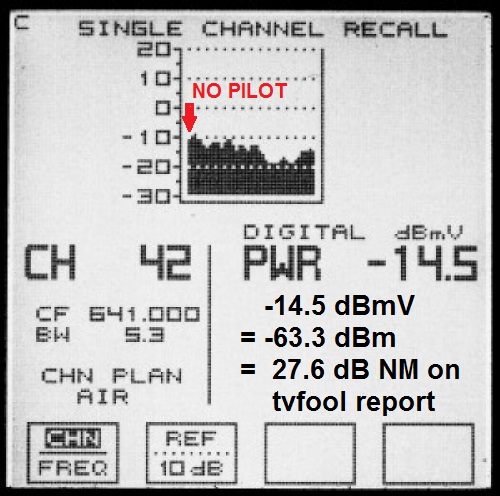Quote:
|
In actual practice, it's quite possible to have a perfect pilot bu have another part of the 5.38 MHz bandwidth completely grunged out due to multipath condition. That would show up as a deep notch, for example, somewhere within that bandwidth.
|
That is correct, but his scan doesn't have a notch, so I think it is worth a try. OP acat is at the point now where he is willing and able to try any experiment to receive channel 9, witness the fact that he climbed the RTL-SDR learning curve with great success. He is even willing to try an Anti-Ghosting Antenna.

I have no desire to discourage a true antenna experimenter; I often learn from them.
And, just to make it more confusing, according to Dr. Bendov, you can have a flat scan without a notch, but the signal doesn't decode because the reflections have filled in the notch.
DTV Coverage and Service Prediction, Measurement and Performance Indices by Dr. O. Bendov, et al.
page 4
VIII. SNR AND “FIELD STRENGTH” MEASUREMENT VIA
SPECTRUM INTEGRATION
Quote:
Defining the Signal as the total received power and the Noise as AWGN (Additive White Gaussian Noise) leads to the conclusion that the SNR at the input to the receiver increases with increased multipath.
In urban and indoor situations, there may not even be a main signal, only reflections, some of which are of equal magnitude.
If all multipath signals are part of the signal power, then the SNR margin may not be an indicative figure of merit of reception robustness. In any case, even accurate measurement of the total received power may not be trivial.
The integrated signal power is not just the Desired Signal power. It includes, Man-made, Galactic, and thermal noises and residual transmitter generated in-band noise. It also includes some but not necessarily all multipath signals. For example, pairs of identical and asymmetric echoes, one of positive amplitude and positive delay relative to the main signal and one of negative amplitude and negative delay relative to the main signal, will cause only a second-order distortion of the displayed power spectrum. They will create group delay. Thus, in a multipath channel, a pair of such echoes would measure high SNR when using the spectrum integration technique whereas in reality, the true SNR would be much lower.
There may be other combinations of echoes that would yield essentially flat spectrum display.
|
I still think it's worth a try because it worked with my Salelco DisplayMax 800 single channel scan.
Here is a signal that is strong enough, but doesn't decode because there is no direct signal, only reflections.

When the antenna was aimed at the transmitter, the signal was received:
